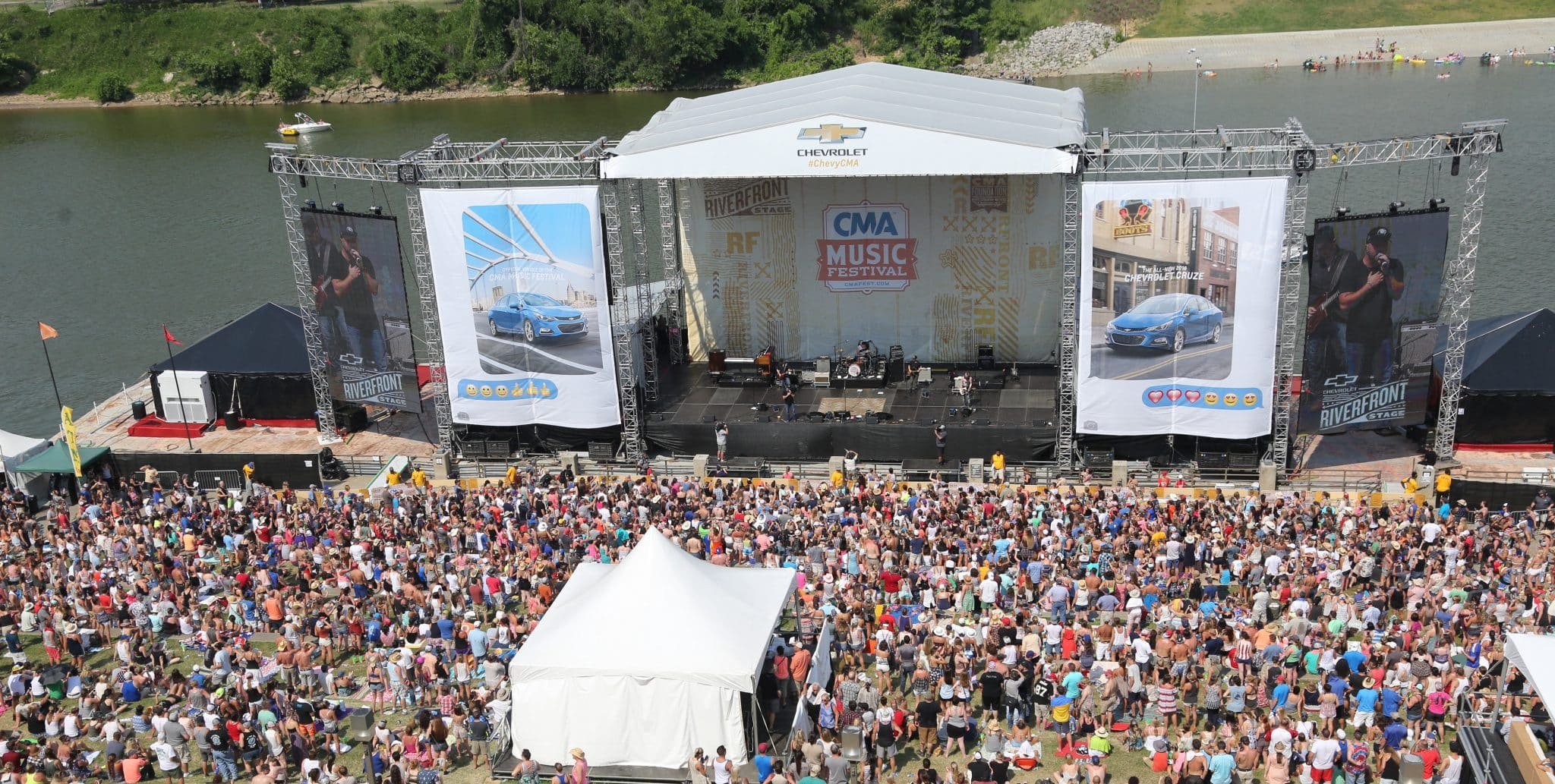Down-Home Big Business: How CMA Fest Became A Branded Juggernaut
By: WENDY PEARL
9:36 AM, FRIDAY, 06/09/2023
CMA Fest isn’t merely an annual pilgrimage for the format faithful. The world’s largest and longest-running country music festival has had a profound impact on the city it calls home and the perception of country music around the globe.
It’s down-home, big business.
The event, which started in 1972 as Fan Fair, has evolved over five decades into a four-day marketing juggernaut with sold-out, star-driven stadium concerts that are taped for a three-hour ABC Television Network summer special, and national brand partnerships that increase awareness and revenue for CMA and the organization’s charitable CMA Foundation division.
Held this year from June 8-11 in Nashville, ticket prices for the nightly concerts at Nissan Stadium, home of the NFL’s Tennessee Titans, start at $85.70 for a single-night ticket and cost $249.35 to $1,434.40 for a four-day pass with seating for roughly 50,000.
The impact of CMA Fest is felt beyond the box office. The annual conclave is a one-of-a-kind celebration of the bond between the fans, the music and the hundreds of artists who make appearances and perform each year for free. (Full disclosure: this article’s author ran CMA’s communications department from 2000 through 2016.) In 2022, after a two-year COVID hiatus, attendance was 80,000 with 83% of attendees coming from out of state. Fans traveled from 39 foreign countries and all 50 states with Florida, New York, Illinois, Kentucky, Ohio and California at the top of the list. The average length of stay was 5.1 nights according to statistics released by the Nashville Convention & Visitors Corp.
CMA Fest is Nashville’s largest annual tourism event with the highest direct visitor spending, which was $65.2 million in 2022 up from $64.9 million in 2019. Held June 9-12 in 2022, CMA Fest helped propel the month to record highs with the largest number of room nights sold – 875,407 – the most room nights ever sold in the county, according to the NCVC.
“Whatever superlative you want to use from grand slam to trifecta to home run, it hit all the buttons,” explained Butch Spyridon, CEO of the NCVC. “It touched on the brand. It touched on PR. It touched on direct revenue for the city. And it had instant media around the event and then a month, two months later, there’s a three-hour primetime network special. So, it became the gift that keeps on giving.”
Originally, marketing was a tool to sell tickets. CMA and then partner WSM Radio and the Grand Ole Opry created the event to give fans an alternative to interrupting industry business at the annual DJ convention. The first International Country Music Fan Fair was held at Nashville’s Municipal Auditorium for an audience of 5,000. The second year the event moved to June and attendance reached auditorium capacity at 10,000.
Fan Fair moved to the Tennessee State Fairgrounds in 1982. Participation capped at 25,000 four-day tickets, which sold out in advance. A large portion of attendees camped at the fairgrounds and local RV parks, while food was provided by the Odessa Chuck Wagon Gang from Texas. The stage was set up on the stock car racetrack and the air conditioning in the livestock barns where artists signed autographs was unreliable.
Marketing and the need to sell more tickets and reach a wider audience became a priority for the CMA Board of Directors and city stakeholders with the decision to relocate to downtown Nashville in 2001.
“I think the move was transformational for Music Fest,” said Spyridon, who served on CMA’s Fan Fair committee at the time. “It was a great event, but the people who came were much more budget conscious – their ticket included a meal every day. The city didn’t benefit financially like it does today and locals didn’t have the opportunity to experience it like they do today. It had served its shelf life at the fairgrounds and it needed reinvention.”
More fans, a larger footprint, suitable venues and extensive media attention provided new opportunities for marketing and increasing consumption of country music beyond the four-day event, which was central to the trade association’s mission.
“It opened up all kinds of opportunities,” recalled Rick Murray, who was head of CMA’s marketing department at the time and is now senior vice president of talent and brand integration at Premiere Networks. “The growth was phenomenal – it was a blank piece of paper. The feeling was if we moved downtown, we would be able to reach a wider audience.”
Rebranded CMA Music Festival in 2004, the event flourished. Zones were created that could be sold to different sponsors to offset costs. Chevrolet expanded their existing CMA Awards relationship to include the festival shortly after the event moved. For seven years, Emily Weaver has managed Chevrolet’s national and in-market media, social and most recently partnerships and experiential marketing for the company.
“With this being our longest standing partnership – and really our primary and only partnership within the country music space – it is very important to us thematically,” Weaver said. During the 2022 CMA Awards, Chevrolet launched a contest with Breland, who wrote part of a song around the new Silverado EV and invited fans to complete it on TikTok. The winner will perform their composition on the Chevy Riverfront stage.
Chevrolet’s sponsorship includes marquee rights to Riverfront and the Vibe stage in Walk of Fame Park. Chevy will activate for the first time on the plaza at the Schermerhorn Symphony Center. Dubbed “Electric Avenue,” the area will feature Chevy’s full fleet of electric vehicles as well as areas for fans to relax and recharge with lounge seating, charging stations, popsicles and a DJ spinning electronic versions of country songs. In addition to static displays, Chevy offers ride share access within a five-mile radius of downtown.
“Through our partnership we get the official designation as the Official Ride, the Official Vehicle of Country Music and we really lean into that, hard,” Weaver said. “Because we know this event attracts the most avid enthusiastic fans. They are there because they love the genre. And they love the artists. And Chevrolet is very much a natural and organic part of country music.”
Emily Weaver | Media, Partnerships, & Divisional Brand Strategy, Chevrolet
Dr Pepper, a two-year stage partner and official soft drink of CMA Fest, is using technology to enhance their participation and promote artists on the rise with an augmented reality campaign with AR company Videobomb. The program features Kroger in-store displays and a QR code that consumers can scan to watch messages from artists with details about how to enter to win an autographed guitar and other prizes. Fans can boost their entries by following the participating artists’ channels and streaming their music.
The average engagement time for someone viewing the content is over a minute. In the first two weeks of the promotion, there were more than 3 million entries.
“Bringing in brands as part of the footprint allows us to have other channels of driving awareness and engagement with the community,” said Kelly Striewski, senior vice president of marketing, content and communications strategy at CMA. “Major brands give us the opportunity to expand beyond the country audience. Chevy or a partner like Dr Pepper have tremendous audiences and it’s a way for us to use that channel of communication to bring eyes and ears to what we’re doing at CMA and CMA Fest.”
Other festival partners include AARP, Bobcat, Busch Light, Celsius, Maui Jim Sunglasses, Polaris, Postmates and more.
The event reaches a wider audience through the annual ABC television special, which aired for the first time in 2004 and is taped each night at Nissan Stadium showcasing the format’s biggest touring acts.
Another important marketing tool in 2023 will be “CMA Fest: 50 Years of Fan Fair,” an original documentary film debuting on Hulu Wednesday, July 5. The documentary marks CMA’s first feature-length film.
The CMA Fest ABC special also airs internationally including Canada, U.K. Mexico, Norway and Germany and has contributed to the growth of the format, according to Milly Olykan, vice president of international relations and development at CMA.
During the festival, CMA hosts an international reception and foreign-based artists perform on CMA’s various stages. In 2023, international artists are coming from Australia and Canada. To better engage with the Nashville music industry, international labels and performing rights organizations host showcases to garner attention and foster business relationships.
Global reach, national brand partners and primetime network and streaming partners make CMA Fest a massive mainstream experience, but the real winners are the music teachers and students who benefit from the money raised by the event.
CMA established the CMA Foundation, a nonprofit 501(c)(3), in 2011 to leverage strategic partnerships, professional development for qualified music teachers and grant distribution to improve music education programs for all students nationwide. Tiffany Kerns serves as executive director of the CMA Foundation and senior vice president of industry relations and philanthropy for CMA.
“For any fan or any consumer, aligning themselves with a brand that is thinking about community, and also thinking beyond being for profit, is attractive,” Kerns said. “We are also walking the walk with the fact that we are taking the funds that are raised through fest and putting them back into communities across the country. It’s just a really good way for our fans to know it is more than just showing up for a concert.”
To date, the CMA Foundation has invested nearly $30 million nationally.
Student musicians routinely perform at the festival and information about the Foundation and its mission is incorporated into all marketing materials, social messaging and signage. The work of the Foundation is made possible because of the generosity of the artists who have performed for free for five decades.
“You don’t see that in any other format,” Murray offered. “That’s the magic of country music in Nashville, Tennessee.”


